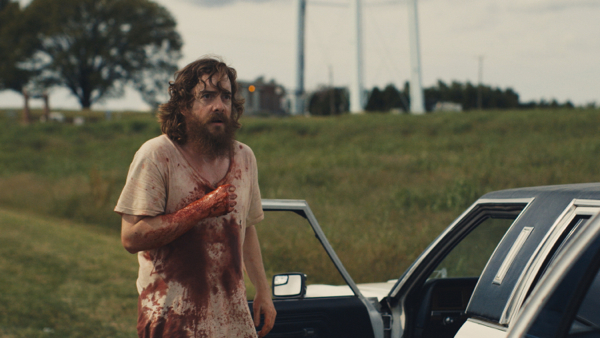Movie review by Greg Carlson
Jeremy Saulnier contributes a worthwhile addition to the family revenge thriller with “Blue Ruin,” a sharp livewire that transcends both its modest budget and the familiar expectations of the genre through the filmmaker’s keen intellectual investments. The umpteenth story to track the efforts of a driven protagonist en route to a climactic bloodbath, “Blue Ruin” unfolds with many of the hallmarks of tales in which the dire consequences of payback offer little in the way of satisfaction to the bereft. Saulnier aligns his stylistic approach with movies like “Blood Simple,” “In the Bedroom,” “Revanche,” “The Place Beyond the Pines” and “Out of the Furnace,” asking us to ponder the consequences of getting even.
From the film’s opening frames, Saulnier proves a shrewd and economical storyteller, carefully doling out just enough information to keep the viewer fully invested in the slow motion horror we are unable to prevent. Haggard and homeless Delaware beach vagrant Dwight Evans (Macon Blair) learns that the man who murdered his parents is soon to be released from prison. Evans returns home to Virginia, and the realization that he intends to do harm to the convicted killer is presented by Saulnier with as much woozy ambiguity as the sinking feeling that Dwight is in way over his head.
One of the unsettling dimensions of “Blue Ruin” is the ease with which Saulnier convinces the viewer to sympathetically align with Dwight in his quest for vengeance. Some of this is accomplished through the construction of the character, played by Blair as a sad-eyed sufferer fulfilling his destiny with a strong sense of doomed resignation. Dwight’s physical transformation, from scruffy, bearded, and emaciated to a smooth-cheeked square in a button-down dress shirt and khaki pants, only adds to his pathetic mismatch against the grim members of the clan he must face.
In his review of the film, David Edelstein asserts that “Aside from ‘Go for it!,’ the most pervasive motif in American film (and TV) is ‘I will have my revenge!’” Edelstein goes on to make the claim that the retribution theme “cheapens what it touches,” implying that our collective fascination with a kind of solipsistic and perverted sense of justice – combined with America’s cultural embrace of guns if not the violence connected to them – signals a depressing celebration of murder.
Edelstein believes that “Blue Ruin” is “drivel,” but his critique fails to account for any number of narrative surprises used by Saulnier as substantive moral and ethical complications standing in the way of Edelstein’s argument that “…there isn’t a second when we don’t think the people in question would be better off dead and that a measure of order will be restored by their killing.”
Edelstein does, however, make a compelling point not unlike some of the conversations about Clint Eastwood’s “Unforgiven” that located the contradiction and disjunction of two seemingly mutually exclusive options regarding stories that simultaneously appear to condemn violence and celebrate violence. Of course, fictions in which common folk resort to extraordinary actions have driven drama since the dawn of theatre. To the extent that it is possible in the movies, Saulnier grasps for ways to illustrate a kind of humanity for the antagonists. Most genre exercises in the vein of “Blue Ruin” don’t treat the “bad guys” with nuance and sophistication, and that’s enough to recommend the movie.
